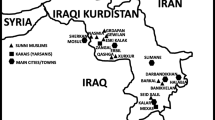Abstract
Western Friuli, Italy, there is a small area near the town of Pordenone where an ancient rite of spring is still carried out. This is the preparation of a special dish, known as “pistic,” a collection of 56wild herbaceous meadow and wood plants which are boiled and then sautéed together. This practice is still alive in a few areas of Friuli today and possibly goes back to pre-Roman Celtic cultures in this part of Friuli. The number of herbaceous plants used in this dish is extraordinarily high (56), especially when compared to the low number normally used in other conventional dishes. “Pistic” is therefore important, not only because it represents a quantitatively high use of wild herbs in the diet of the rural population, but also because it reflects environmental awareness, in that the archaic method of naming, identifying and using these plants still exists today. Similar rural practices include the use of “pot herbs” in Great Britain and in France the cooking of “mesclun.”
Résumé
Dans le Val Colvera, dans l’ouest de Frioule, au nord-est de l’ltalie, il existe une petite région, prés de la ville de Pordenone oú un ancien rituel printanier a toujours cours. Il s’agit de la préparation d’un plat spécial, connu sous le nom del “Pistic,” á base de 56 especes herbacées sauvages des prés et des bois, qui sont bouillies, puis rissolées ensemble. Cette pratique est toujours vivante dans quelques régions du Frioule et il est possible de la retrouver jusque dans les cultures celtique, pre-romaines, qui une et des actives dans cette partie du Frioule. Le nombre d’espéces herbacées utilisées est exceptionnellement élevé (56), spécialement quand on le compare au nombre normalement bas d’espéces utilisées dans d’autres plats. Le Pistic est done important, non seulement parce quil représente un usage important d’herbes sauvages dans le régime des populations rurales, mais aussi parce que la nomenclature archaïque, utilisée encore actuellement pour identifier ces plantes est toujours en usage, refléte une sensibilité a l’environment.
Similar content being viewed by others
Literature cited
Alarcon Gallegos, R. 1988. Etnobotanica de los Quinchuas de la Amazonia Ecuatoriana. Miscellaneous Antropologica Ecuatoriana, 7:1–178.
Altieri, M. A., and L. C. Merrick, 1988. Agroecology and in situ conservation of native crop diversity in the third world. Pages 361–369in E. O. Wilson, ed., Biodiversity, Nat. Ac. Press, Washington DC.
Corbetta, F. 1991. Piante spontanee mangerecce. Edagricole, Bologna.
Costantini, G. 1941. Litún e Lidún, erbucce primaverili mangerecce nella tradizione popolare fnulana. Rivista “Lares”, Roma.
De Rougement, G. 1990. Guida delle piante utili, le piante coltivate ad uso commerciale in Europa. Franco Muzzio, ed., Padova.
Kruta, V. 1986. I Celti Occidental, De Agostini ed., Novara.
Mansuelli, G. A. 1978. Le fonti storiche sui Celti Cisalpini. Pages 71–75in Soprintendenza Archeologica di Roma, I Galli e l’ltalia. De Luca ed., Roma.
Paoletti, M. G., D. Pimentel, B. R. Stinner, and D. Stinner. 1992. Agroecosystems biodiversity: matching production and conservation biology. Agriculture Ecosystems and Environment 40:3–23.
Paoletti, M. G., and D. Pimentel. 1992. Biotic diversity in agroecosystems. Elsevier.
Pellegrini, G. B., and A. Zamboni. 1982. Flora popolare Fríulana. Casamassima ed., Udine.
Pignatti, S. 1982. Flora d’ltalia. Edagricole, Bologna.
Pimentel, D., and M. Pimentel. 1979. Food, energy and society. Edward Arnold, London.
Piovan, C. 1986. Comensi, Etruschi e Celti: le ragioni di una mostra. Pages 11–15in Societá Archeologica Comense, Como fra Etruschi e Celti. La cittá preromana e il suo ruolo commerciale, Como.
Reid W. V., and K. R. Miller, 1989. Keeping options alive. The scientific basis for conserving biodiversity. World Resources Institute.
Rieppi, A. 1941. Piante mangerecce spontanee del Friuli. Comitato Nazionale Forestale.
Vitri, S. 1990. Indagini recenti nei complessi archeologici protostorici e dell’etá della romanizzazione. Pages 177–192in G. Bandelli, S. Corazza, S. Crevatin, F. Fontana, S. Pettarin, C. Tirone, and S. Vitri, eds., Montereale fra protostoria e storia. Contributi preliminari. Biblioteca Civica di Montereale Val Cellina.
Williams, J. T. 1988. Identifying and protecting the origin of our food plants. Pages 240–247in E. O. Wilson, ed., Biodiversity, National Academy Press, Washington DC.
Zangheri, P. 1976. Flora italica. CEDAM, Padova.
Author information
Authors and Affiliations
Rights and permissions
About this article
Cite this article
Paoletti, M.G., Dreon, A.L. & Lorenzoni, G.G. Pistic, traditional food from Western Friuli, N.E. Italy. Econ Bot 49, 26–30 (1995). https://doi.org/10.1007/BF02862273
Received:
Accepted:
Issue Date:
DOI: https://doi.org/10.1007/BF02862273



